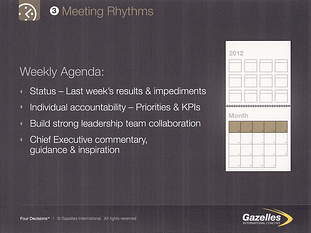There are a lot of reasons to not like meetings. This is certainly the case if they are ill defined, lack structure, and are devoid of purpose.
That’s not the type of meetings we recommend in Rockefeller Habits Strategic Discipline.
Meetings have intention and are tied to the achievement of quarterly and annual priorities. The meetings should improve morale, accountability, and focus.  Let’s look at a weekly meeting structure based on the Strategic Discipline principles:
Let’s look at a weekly meeting structure based on the Strategic Discipline principles:
Good News: Each weekly meeting starts with good news both personal and business. The business good news is perhaps easy to appreciate. Most businesses frequently fail to broadcast or celebrate our accomplishments. Often we as individuals fail to realize just how much we’ve achieved. Recognizing good news celebrates and communicates these victories to the leadership team. The personal portion of this is often more difficult to appreciate. Sharing your personal good news helps bring the team together. Vulnerability and learning about what’s important to the members of your team improves morale and teamwork. It also helps everyone to get beyond the Fundamental Attribution Error. Time: 5 minutes
Numbers: This is a critical element to your meeting. Every leadership team member provides an update on his department progress by sharing their dashboard. The dashboard should be color coded in Red (Failing), Yellow (Making Progress but short of goal), Green (Achieving Goal), or Super Green (Surpassing Goal) to indicate progress. The color code allows the information to be presented quickly, and gives a clear indication where teams are on target or need help. The company dashboard can be updated here as well, however in many cases each element of the company dashboard is on a leadership team’s dashboard, so the company dashboard can be updated simply in the monthly meeting. This section is an important component for increasing accountability. As noted in Accountability - Three Reasons Group Meetings Produce Better, an executive team dashboard in the red likely will work harder to improve to prevent being embarrassed again. Time: 5-10 Minutes
Customer and Employee Data: Here’s where a great deal of sharing and communicating occurs. What or where are the recurring issues or concerns that the team or its customers are facing day in and day out. Often times the sharing that occurs here alerts every one of potential issues. Customer or employee complaints in many business fail to register on the radar before it’s too late. If a problem is brought up here and not dealt with, then reoccurs you can bet it will be noticed. If there a number of concerns move these to collective intelligence, or choose an issue, assign a person or small group to explore, and get to the root cause of it. The person or group can bring back recommendations on how to tackle it. Time: 10 Minutes
Who What When Accountability: Each meeting individual and team accountabilities should be tracked with due dates. At the quarterly meeting as an example dashboards for each leader should be required to be completed by the following weekly meeting. The assignment of a person or group to deal with recurring issues and bring back solutions can be tracked this way also. Responsibility is assigned and once again peer pressure exerts it’s influence to ensure results occur. Time: 5-10 Minutes
Collective Intelligence: This should focus on a rock or large priority. Get everyone’s input and drill into one of your big issues. This can be something that’s been recurring for some time and scheduled for addressing in this meeting, or issues that have been discussed or discovered through the numbers or customer and employee data. In the case of scheduling recurring issues, a presentation on one of these rocks can be delivered, with the person accountable leading it. Depending on the time it’s taken for the other portions of the meeting this can section can last 10 to 45 minutes. Don’t underestimate the value this can bring. Collective intelligence, harnessing the collective abilities and experience of your entire team can offer significant contributions and ideas for solving the difficult challenges your business face. Where else can you get your team together to work on issues regularly? This opportunity should be exploited and revered for the treasured results it can produce. Time: 10–30 Minutes
One Phrase Closes: Everyone in the meeting is required to deliver a word or phrase about how they feel about the meeting. Why do we recommend this? In a few seconds you can quickly determine who the meeting impacted and what was accomplished. People who did not contribute often have difficulty responding. Those who it helped and impacted will have positive upbeat descriptions. You can learn a lot simply by paying attention to these responses. Time: 3-5 Minutes
Add the times up for about a 60 minute minimum. Some segments go longer some shorter depending on the week. This is also dependent upon how many people are in your meetings (Never be more than 10). A critical reminder these weekly meetings need to be tied to your quarterly priorities. This requires preparation. A half day to two full days of strategy and planning should be scheduled before each quarter begins. It also requires basing decisions on your annual planning session that you did before the year started.
Questions about how to develop this and the entire concept of Strategic Discipline please contact us or plan to attend Mastering the Rockefeller Habits Four Decision Workshop in November.
Can creating dashboards help you bring out the best in your people? We’ll explore this in our next blog.






.jpeg?width=150&height=135&name=Hand%20with%20marker%20writing%20the%20question%20Whats%20Next_%20(1).jpeg)

